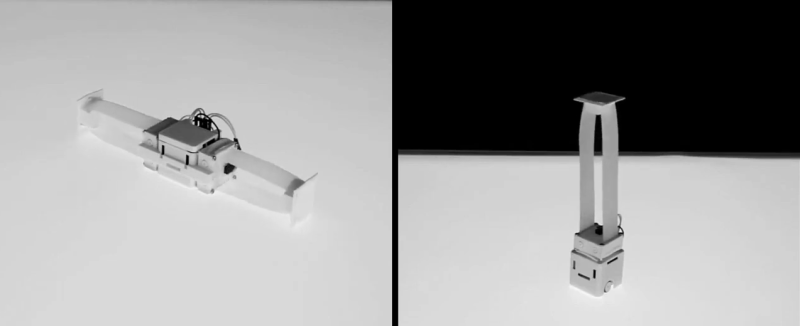Sometimes one just needs an extra hand or six around the workbench. Since you’re a hacker that should take the form of a tiny robot swarm that can physically display your sensor data, protect you against a dangerously hot caffeine fix and clean up once you’re done. [Ryo Suzuki] and [Clement Zheng] from the University of Colorado Boulder’s ATLAS Institute developed ShapeBots, small shape-shifting swarm robots that aim to do exactly that and more.
The robots each consist of a cube shaped body with 2 small drive wheels, onto which 1-4 linear actuator modules can attach in various positions. For control the robots’ relative positions are tracked using an overhead camera and is shown performing the tasks mentioned above and more.
To us the actuators are the interesting part, consisting of two spools of tape that can extend and retract like a tape measure. This does does lead us to wonder: why we haven’t seen any hacks using an old tape measure as a linear actuator? While you likely won’t be using it for high force applications, it’s possible to get some impressive long reach from a small from factor. This is exactly what the engineers behind the Lightsail 2 satellite used to deploy it’s massive space sail. Space the two coils some distance apart and you can even achieve full 2-axis motion.
You can also control your swarm using your favourite wifi chip or have them skitter around using vibration or 3D print some linear actuators.
Thanks for the tip [Qes]!
















I have played with two tape measure strips used as alinear actuator. I was inspired by the linear actuator design of [Roger rabbit]. I put velcro/hook and loop on the inner faces of the tape and forced them together to give it more cooperative strength but still allows them to be pulled apart when retracted. It was fun but needs careful guidance and support of the tape to get it to extend, rather than unravel inside the drums / voids around the storage reels. I used two but I think the curved metal tape would lend itself to a third tape, potentially making a stronger beam in more lateral loading directions (and less prone to buckling from longitudinal loads). If you could apply the extending drive to the tape itself, rather than the storage reels, as I did, I think it would work better.
*a linear, not “alinear”.
I remember seeing satellite antennas made from extendable metal tape that deployed once the satellite was in orbit. If what you need is mechanical support rather than conductivity, perhaps a soda straw split lengthwise and then coiled onto a spool for extension / retraction would work.
soda-straw! You, sir, are a genius! Just tried it, surprisingly functional!
Thanks. I tried spooling two split straws face-to-face so that they nest when extended. The extension is stronger but spooling and unspooling is trickier.
Ah hah, had to read that a couple times… two layers of straws, so the slits are opposite? Also intriguing.
I tried two different straws of differing material and definitely they function differently. One, once slit, curls in on itself effectively making 1.5 circles! Though, after multiple ex/retractions that springiness was lost, it might be reinforceable with rollers.
I also considered making tape-measures circular, and as a quick experiment tried to roll a regular one a bit more cylindrical by hand. Even just a tiny additional “roll” makes a huge difference in its rigidity. I wound-up pinching three fingertips around the tape, two on the back near the edges, thumbnail riding the top in the middle, dragging the tape for about a foot. The effect of the additional rolling is barely visible, but in that foot it is significantly less-prone to “flopping.”
I also taped several straws end-to-end [overlapping a bit] and it still seems to work well-enough. Sturdy-enough for my needs for several feet. Thanks!
Surely improvable in many ways, if needed, e.g. wire rings spaced by string, extending every 4 inches during extraction… rollers to “form” it into two full circles, etc.
Well at some point it degenerates from a soda straw hack into real design work.
Pritsticks and mechanical pencils make pretty good linear actuators.
I totally approve the decision to make them look like this: ‘-‘